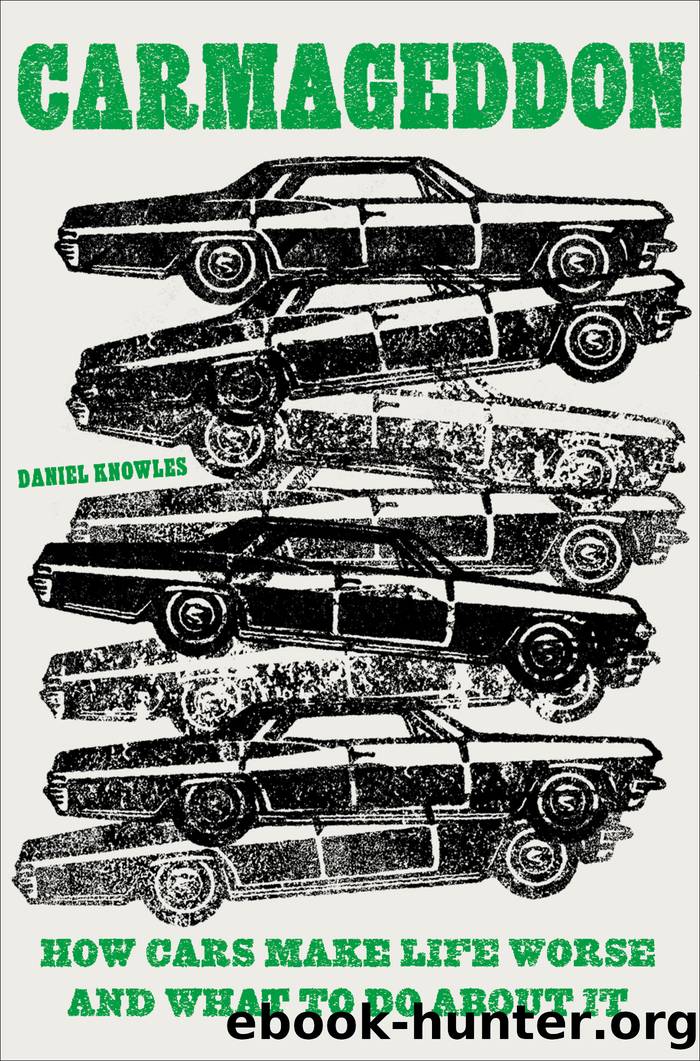Carmageddon by Daniel Knowles

Author:Daniel Knowles
Language: eng
Format: epub
Publisher: Abrams
Published: 2023-03-28T00:00:00+00:00
10
FREE PARKING, DO NOT PASS GO
When most people think of Los Angelesâs architecture, they probably imagine some of the cityâs gems. There is Frank Gehryâs concert hall downtown, a wonderful construction of curved steel intended to look something like a ship. There is the Getty Center, high up on the hills of Brentwood, overlooking the city. There is the Bradbury Building, a late Victorian wonder of ornate iron walkways featured in the final scenes of Blade Runner. And then there are any number of grand, modernist palaces of the sort that dot the Santa Monica seafront or rise up into the hills of the Pacific Palisades.
And yet, for many architects at least, the characteristic building of Los Angeles is none of these. It is in fact a far humbler building, known as the âdingbat.â This is essentially a squat block of apartments, sitting on top of what Americans call a âcarport.â The lower floor is occupied by cars; the upper one or two floors by modest-size apartments, typically one or two bedrooms. The buildings are boxy, with wooden frames and stucco exteriors. Often they come with 1950s Americana stylings, with names such as âthe Hansenâ or the âPink Flamingoâ emblazoned on the outside in stylized italics. You see them often in movies set in Los Angeles, if you know what to look for. The 1998 comedy The Slums of Beverly Hills features a family forced to move constantly between dingbats.
The name was first put into print by Reyner Banham, a British architectural critic who fell in love with Los Angeles and its automotive spirit in the 1970s, though he credited it to Francis Ventre, another architect. In the 1950s and â60s, tens of thousands of these buildings were thrown together by developers to create cheap housing for the inflow of workers to California, drawn to jobs in the aerospace and manufacturing industries flourishing there. They are typically near roads, especially the freeways, which were also spread across LA during that period. They represent perhaps the archetypical automotive sort of property. They are both compact, in terms of the living area, while being sprawling, because of the space taken up by the roads and car parking.
They also owe their existence, in large part, to a prominent feature of LAâs postwar planning. In 1958, the city required new apartments with more than âthree habitable roomsâ to have, on average, 1.25 parking spaces. So a block of twelve apartments would require fifteen car parking spaces. This restraint, strictly enforced, compelled architects to plan their construction not around the needs of the people who would live in the apartments, but more around the needs of their cars. According to Steven Treffers, an architectural historian, âArchitects would typically work backward from these regulations, determining how many parking spaces could be provided based on the number of automobiles they needed to accommodate.â And so the dingbat was born.
Hundreds of thousands of them had been built, sprawling out into the San Fernando Valley. They illustrate one of the quiet but enormous ways in which the car has shaped cities worldwide, especially in America.
Download
This site does not store any files on its server. We only index and link to content provided by other sites. Please contact the content providers to delete copyright contents if any and email us, we'll remove relevant links or contents immediately.
| Automotive | Aviation |
| History | Mass Transit |
| Owner's Manuals & Maintenance Guides | Railroads |
| Reference | Ships |
Small Unmanned Fixed-wing Aircraft Design by Andrew J. Keane Andras Sobester James P. Scanlan & András Sóbester & James P. Scanlan(32149)
Navigation and Map Reading by K Andrew(4560)
Endurance: Shackleton's Incredible Voyage by Alfred Lansing(3857)
Wild Ride by Adam Lashinsky(1661)
And the Band Played On by Randy Shilts(1623)
The Box by Marc Levinson(1603)
Top 10 Prague (EYEWITNESS TOP 10 TRAVEL GUIDES) by DK(1572)
The Race for Hitler's X-Planes: Britain's 1945 Mission to Capture Secret Luftwaffe Technology by John Christopher(1531)
The One Percenter Encyclopedia by Bill Hayes(1470)
Girls Auto Clinic Glove Box Guide by Patrice Banks(1370)
Trans-Siberian Railway by Lonely Planet(1351)
Looking for a Ship by John McPhee(1324)
Batavia's Graveyard by Mike Dash(1306)
Fighting Hitler's Jets: The Extraordinary Story of the American Airmen Who Beat the Luftwaffe and Defeated Nazi Germany by Robert F. Dorr(1305)
Troubleshooting and Repair of Diesel Engines by Paul Dempsey(1289)
Bligh by Rob Mundle(1279)
TWA 800 by Jack Cashill(1257)
The Great Halifax Explosion by John U. Bacon(1234)
Ticket to Ride by Tom Chesshyre(1233)
